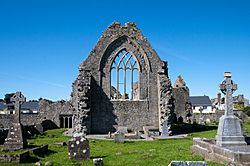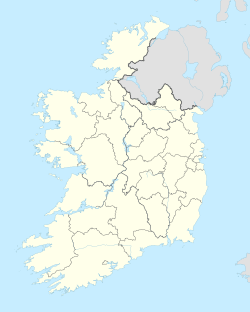Athenry Abbey facts for kids
| Prióireacht Peadar agus Pól, Baile Átha an Rí | |

east window
|
|
| Monastery information | |
|---|---|
| Other names | Ath-na-riogh; Ath-na-rig; Anry |
| Order | Dominican Order |
| Established | 1241 |
| Disestablished | 1574; 1698 |
| Diocese | Tuam |
| People | |
| Founder(s) | Meyler de Bermingham |
| Architecture | |
| Status | ruined |
| Style | Late Gothic |
| Site | |
| Location | Abbey Row, Athenry, County Galway |
| Coordinates | 53°17′54″N 8°44′40″W / 53.298236°N 8.744544°W |
| Public access | yes |
| Official name | Athenry Abbey Priory (Dominican) |
| Reference no. | 164 |
The Priory Church of Saint Peter and Saint Paul, Athenry, often called Athenry Priory, is an old Dominican priory in Athenry, Ireland. It is also a special National Monument. This means it is a very important historical site.
Contents
Where is Athenry Priory?
Athenry Abbey is found in the eastern part of Athenry town. It is located just east of the Clarinbridge River.
A Look Back: History of Athenry Priory
How the Priory Started
The priory was founded in 1241 by a man named Meyler de Bermingham. Other important local leaders helped pay for it. Feidlim Ua Conchobair, who was the King of Connacht, built the dining hall. Owen Ó hEidhin built the sleeping area, called the dormitory. Conchobar Ó Cellaigh built the chapter house, where meetings were held.
At first, the priory was built near the town walls. Later, the walls were expanded to go around the priory.
Important Events and People
In 1242, a big meeting for the Dominican order was held at Athenry. This was called a provincial chapter. Flann Mac Flainn, who was the Archbishop of Tuam, built a house for students in the 1250s.
Meyler de Bermingham, the founder, was buried at the priory in 1252. His son, William de Bermingham, also became an Archbishop. He was buried there in 1312.
The dining hall was built around 1265. The chapel was finished before 1340.
In 1324, William Liath de Burgh gave money to make the church and priory bigger. This work was finished by 1345. In 1408, Joanna de Ruffur left money for new windows. These new windows were for the east side and the choir area of the church.
Challenges and Changes
Athenry Priory was burned in 1423. To help with repairs, special permissions called indulgences were given by the Pope. These encouraged people to donate money.
In 1451, the friars built a new chapel. This was on land given to them by Ulick Ruadh Burke.
The monastery was officially closed down in 1574. It was burned again during an uprising in the 1570s. However, some friars came back and lived there from 1595 to 1597.
In 1644, Athenry was briefly used as a university. But it was closed again in 1652 by soldiers. The friars last lived in the priory between 1685 and 1698.
In the 1700s, the priory was used as a military barracks. This means soldiers lived there. The last person from the de Bermingham family buried at Athenry was Lady Mathilda Bermingham, who died in 1788. The main tower of the priory fell down around 1790.
What Remains Today: The Buildings
The parts of the priory that are still standing include the nave (main part of the church), the chancel (area around the altar), and a northern aisle and transept (side parts of the church). There are also tombs from the 1200s to the 1400s.
The tall, narrow windows in the chancel are likely from the 1200s. The rest of the building parts are from the 1300s.
Images for kids






